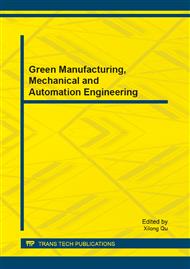[1]
C. Zhuyun. Research of non-linear prediction and identification omen of coal and gas outburst by support vector machines [D], China University Mining and Technology, (2009).
Google Scholar
[2]
C. Jian, Bai Jingyi , QIAN Jiansheng, Short-Term Forecasting Method of coalmine Gas Concentration Based on Chaotic Time Series[J], Journal of China University of Mining & Technology2008, 27(02): 231~235.
Google Scholar
[3]
S. Shiliang, SONG Yi1, HE Liwen. Research on determ ination of chaotic characteristics of gas gush based on time series in excavation working face of coal mine[J]. Journal of China Coal Society. 2006, 31(6): 701~705.
Google Scholar
[4]
F. Takens. Detecting strange attractors in turbulence. [J]. Dynamical Systems and Turbulence, 1981, 898: 366~381.
DOI: 10.1007/bfb0091924
Google Scholar
[5]
Q. Meiying, Ma Xiaoping, Lan Jianyi. Time Series Short Term Gas Prediction Based on Weighted LS-SVM [J]. Journal o f Mining & Safet y Engineering, 2011, 28 (2): 310~314.
Google Scholar
[6]
W. Haiyan, Lu San. Nonlinear time series analysis and application[M]. Beijing: Science press. (2006).
Google Scholar
[7]
L. Cao. Practical method for determining the minimum embedding dimension of a scalar time series[J]. Physica D: Nonlinear Phenomena, 1997, 110(1-2): 43~50.
DOI: 10.1016/s0167-2789(97)00118-8
Google Scholar
[8]
T. Gautama, Mandic D P, Van Hulle M M. A differential entropy based method for determining the optimal embedding parameters of a signal[C]. Hong Kong, Hong kong: (2003).
DOI: 10.1109/icassp.2003.1201610
Google Scholar
[9]
L. Shida, Liang Fuming, Liu Shishi. Chaos and Fractal of Natural Science[M]. Beijing: Beijing University Press. (2003).
Google Scholar
[10]
H. Min. Chaotic Time Series Prediction Theory and Method [M]. Beijing: China Water Power Press. (2007).
Google Scholar
[11]
J. Argyris, Andreadis I, Pavlos G, et al. On the influence of noise on the largest Lyapunov exponent and on the geometric structure of attractors[J]. Chaos, solitons and fractals, 1998, 9(6): 947~958.
DOI: 10.1016/s0960-0779(97)00145-8
Google Scholar
[12]
J. Argyris, I. Andreadis. On the influence of noise on the largest Lyapunov exponent of attractors of stochastic dynamic systems[J]. Chaos, solitons and fractals, 1998, 9(6): 959~963.
DOI: 10.1016/s0960-0779(97)00146-x
Google Scholar
[13]
H. Liu, Z. Dai , W. Li , et al. Noise robust estimates of the largest Lyapunov exponent[J]. Physics Letters A, 2005, 341(1-4): 119~127.
DOI: 10.1016/j.physleta.2005.04.048
Google Scholar


